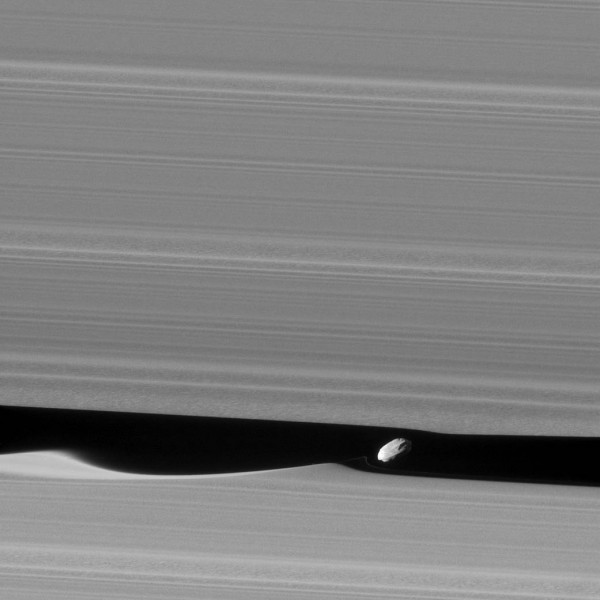By Ana Verayo, | January 20, 2017

Daphnis (5 miles or 8 kilometers across) orbits within the 42-kilometer (26-mile) wide Keeler Gap. ( NASA/JPL-Caltech/Space Science Institute)
The Cassini probe has been zipping through Saturn's orbit for more than a decade. Now, for the first time, the spacecraft captured a photo of one of Saturn's tiny moons, Daphnis, hidden in between its majestic ring system.
Like Us on Facebook
Since 2004, NASA's Cassini mission has provided breathtaking views of Saturn and its ring plane along with never before seen imagery of its elusive moons. Upon closer inspection, ripples and waves are seen within these rings that are apparently formed by gravitational forces from the moons that are between the ring gaps.
One of these gaps known as the Keeler Gap, a small five-mile wide moon called Daphnis is embedded along with small particles from the ring's borders.
From this viewing angle, it appears to be Cassini captured this down below the ring plane but this was captured from the side. The waves in the foreground can also be seen in a rippling pattern as the moon orbits the gas giant.
This ring gap also seems more narrow than its actual 26-mile width due to an optical illusion. This image of "wavemaker" moon Daphnis was taken on January 16, at a distance of 17,000 miles.
This image is also the closest yet of Daphnis as mysterious features are highlighted. A narrow ridge can also be seen running across its equatorial region along with a smooth layer covering its surface, similar to other moons within Saturn's ring system, Pan and Atlas.
Mission scientists suggest that ring particles around Daphnis are formed from past collisions that accumulated in this orbit. Daphnis also has small craters which also means that the moon is prone to violent impacts.
The Cassini mission will end this September. However, future observations are set to become more exciting as the probe will settle itself in Saturn's polar orbits in the next months, even deeper into the ring plane. This has never been attempted before.
-
Use of Coronavirus Pandemic Drones Raises Privacy Concerns: Drones Spread Fear, Local Officials Say

-
Coronavirus Hampers The Delivery Of Lockheed Martin F-35 Stealth Fighters For 2020

-
Instagram Speeds Up Plans to Add Account Memorialization Feature Due to COVID-19 Deaths

-
NASA: Perseverance Plans to Bring 'Mars Rock' to Earth in 2031

-
600 Dead And 3,000 In The Hospital as Iranians Believed Drinking High-Concentrations of Alcohol Can Cure The Coronavirus

-
600 Dead And 3,000 In The Hospital as Iranians Believed Drinking High-Concentrations of Alcohol Can Cure The Coronavirus

-
COVID-19: Doctors, Nurses Use Virtual Reality to Learn New Skills in Treating Coronavirus Patients







